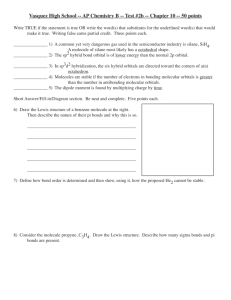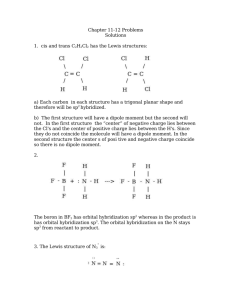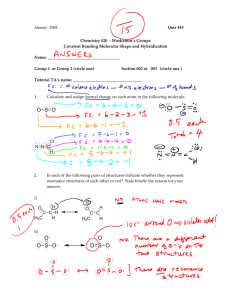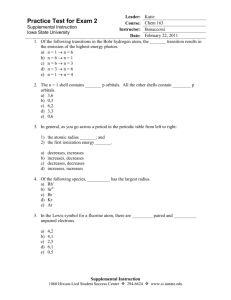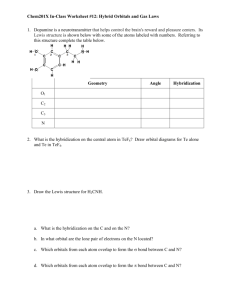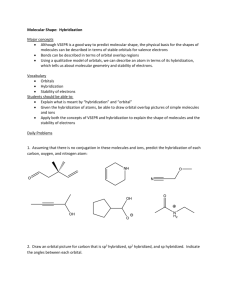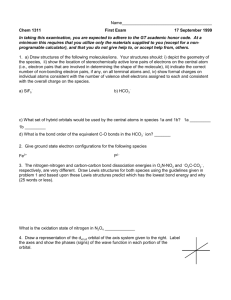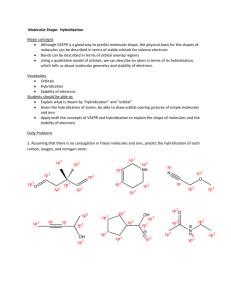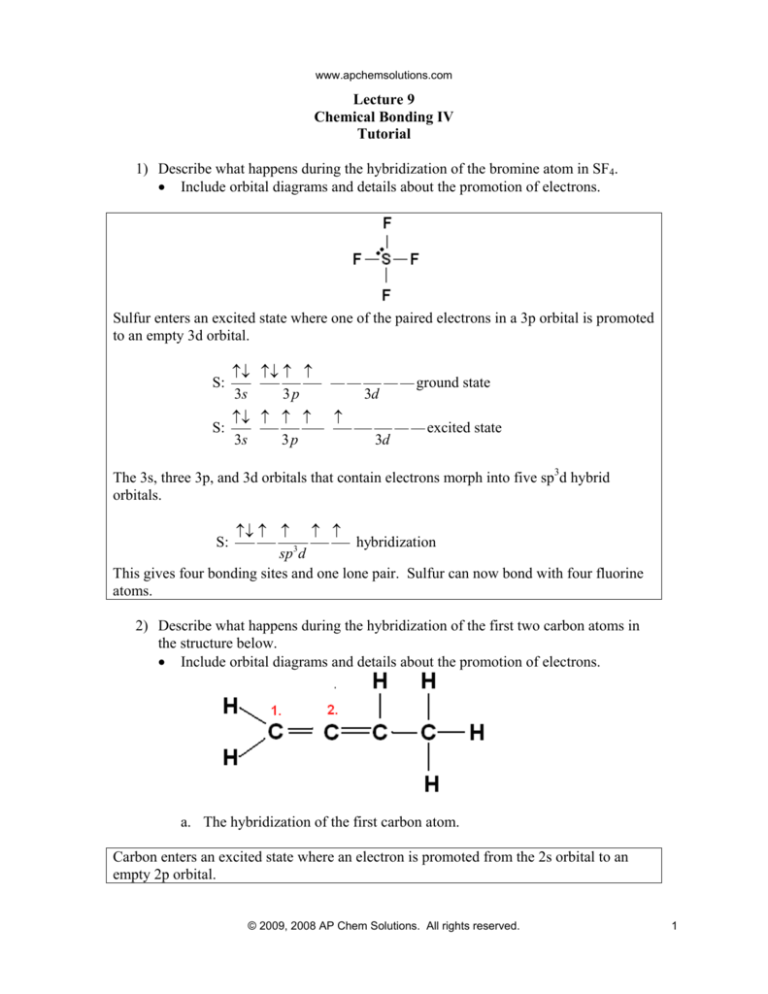
www.apchemsolutions.com
Lecture 9
Chemical Bonding IV
Tutorial
1) Describe what happens during the hybridization of the bromine atom in SF4.
• Include orbital diagrams and details about the promotion of electrons.
Sulfur enters an excited state where one of the paired electrons in a 3p orbital is promoted
to an empty 3d orbital.
S:
↑↓ ↑↓ ↑ ↑
3s
3p
S:
↑↓ ↑ ↑ ↑
3s
3p
3d
↑
3d
ground state
excited state
The 3s, three 3p, and 3d orbitals that contain electrons morph into five sp3d hybrid
orbitals.
↑↓ ↑ ↑ ↑ ↑
hybridization
sp 3 d
This gives four bonding sites and one lone pair. Sulfur can now bond with four fluorine
atoms.
S:
2) Describe what happens during the hybridization of the first two carbon atoms in
the structure below.
• Include orbital diagrams and details about the promotion of electrons.
a. The hybridization of the first carbon atom.
Carbon enters an excited state where an electron is promoted from the 2s orbital to an
empty 2p orbital.
© 2009, 2008 AP Chem Solutions. All rights reserved.
1
www.apchemsolutions.com
C:
↑↓ ↑ ↑
2s
2p
ground state
↑ ↑ ↑ ↑
excited state
2s
2p
The 2s and the two 2p orbitals morph into three identical sp2 hybrid orbitals. One
unmorphed 2p orbital remains.
↑ ↑ ↑ ↑
C:
hybridization
sp 2
2p
Carbon now has three bonding sites, which will allow it to bond with one carbon and two
hydrogen atoms. The unmorphed 2p orbital will form a π bond with the second carbon
C:
b. The hybridization of the second carbon atom.
Carbon enters an excited state where an electron is promoted from the 2s orbital to an
empty 2p orbital.
↑↓ ↑ ↑
C:
ground state
2s
2p
↑ ↑ ↑ ↑
excited state
2s
2p
The 2s orbital and one 2p orbital morph into two identical sp hybrid orbitals. Two
unmorphed 2p orbitals remain.
↑ ↑
↑ ↑
C:
hybridization
sp sp 2 p 2 p
Carbon now has two bonding sites, which will allow it to bond with two carbon atoms.
One unmorphed 2p orbital will form a π bond with the first carbon and the other will
form a π bond with the third carbon – making two double bonds.
C:
3) Is chlorine trifluoride polar or non-polar? Explain by discussing shape, dipolar
bonds, and whether dipoles cancel.
The bromine trifluoride molecule has a T-shaped geometry where the chlorine atom is
bonded to three fluorine atoms and has two lone pairs. The individual bonds are polar, as
fluorine is more electronegative than chlorine. The overall compound is also polar, as
the dipoles do not cancel.
© 2009, 2008 AP Chem Solutions. All rights reserved.
2
www.apchemsolutions.com
4) Is the methane (CH4) polar or non-polar? Explain by discussing shape, polar
bonds, and whether dipoles cancel.
Methane has a tetrahedral geometry where the carbon atom is bonded to four hydrogen
atoms and has no lone pairs. The individual bonds are polar, as carbon is more
electronegative than hydrogen. However, the overall compound is non-polar, as the
dipoles cancel. (The structure is perfectly symmetrical.)
5) Is NBr3 polar or non-polar? Explain by discussing shape, dipolar bonds, and
whether dipoles cancel.
NBr3 has a trigonal pyramidal geometry where the nitrogen atom is bonded to three
bromine atoms and has one lone pairs. The individual bonds are polar, as bromine is less
electronegative than nitrogen. The overall compound is also polar, as the dipoles do not
cancel. The nitrogen end is slightly negative and the bromine ends are slightly positive.
© 2009, 2008 AP Chem Solutions. All rights reserved.
3

